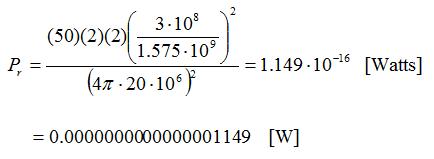|
Many parameters related to antennas are measured in decibels; for instance, gain is often specified in decibels, written as 10 dB.
Or maybe the minimum received power for an antenna system to work is specified as -70 dBm (decibels relative to a milliWatt). Or the transmit
power of your cell phone is given as -3 dB.
Why is this? Why don't they just tell you how much power is transmitted in Watts or the
gain of an antenna in regular (linear) units?
The decibel system is used when quantities can vary by massive amounts. The Richter scale for earthquakes is also on a scale similar to
decibels, because the magnitude of earthquakes can vary from barely perceptible with sophisticated equipment to earthquakes that demolish
vast amounts of land. As an example, lets look at power received by an antenna relative to power transmitted.
Suppose we have an antenna transmitting 50 Watts of power, with a gain of 2 (=3 dB) in the direction of a receive antenna with a gain
of 2 (=3 dB). Suppose the antennas are separated by 20,000 kilometers (as is the typical orbit of a gps satellite). The GPS satellites
operate at a frequency of 1.575 GHz. How much power is received?
Using the Friis Transmission Equation and
the fact that wavelength equals c/f, we can calculate the received power to be:


Of the 50 Watts transmitted, about 2.3e-16% of that power gets through. Incidentally, this might seem frighteningly small,
but yes, antenna systems can operatte with this much power. So be patient with the GPS unit in your car, it is doing a good job.
Antenna engineers (all engineers actually) don't like to use linear units when the quantities can vary by such large amounts.
Its real tough to picture in your head the difference between 1e17 and 1e18. To work around this, we use the decibel system. Its a
simple logarithmic transformation - units in linear are easily converted via:

Hence, the above quoted value of 1.149e-16 Watts is equal to -159.4 decibels, written -159.4 dB.
To give a cemented idea on the conversions, a table of linear to decibel levels is presented.
Table I. Conversion between Linear Units and Decibels.
| Linear Value | dB Value |
|---|
| 1e-10 | -100 dB |
| 1e-9 | -90 dB |
| 1e-6 | -60 dB |
| 1e-3 | -30 dB |
| 1e-1 | -10 dB |
| 0.5 | -3 dB |
| 1 | 0 dB |
| 10 | 10 dB |
| 100 | 20 dB |
| 1e3 | 30 dB |
| 1e6 | 60 dB |
Another common unit is dBm. This means "decibels relative to a milliWatt". In this case, we are talking
about power, and the power is just specified in milliWatts instead of Watts. So:
1 W = 1000 mW = 0 dB = 30 dBm
Or
0 dBm = -30 dB = 0.001 W = 1 mW
Another common variation on dB in antenna theory is dBi which means "decibels relative to an isotropic antenna". This
just specifies the gain of an antenna relative to the isotropic gain, which is 1. So really nothing changes...:
Gain of 10 dB = Gain of 10 dBi
The reason people specify dBi sometimes is that other relative values are sometimes specified, like dBd. This means
"decibels of gain relative to a standard half-wave dipole antenna". The gain of a half-wave dipole is 2.15 dBi. So:
Antenna with a gain of 10 dBi = 10 dB = 7.85 dBd
Gain of half-wave diple antenna = 2.15 dBi = 0 dBd
Another nice feature of decibels is they make multiplication problems become addition, as seen
on the decibel math page.
|